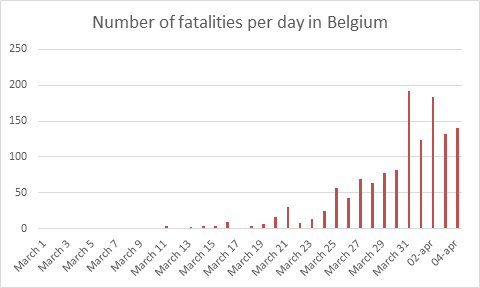Since the outbreak of the coronavirus, the mortality rate has been difficult to estimate and different figures have been given.
The initial estimate by the World Health Organisation was 2 % but the organisation recognized quickly that the figure very provisional and might change as more data were collected.
In the report of the WHO-China Joint Mission at end of February, WHO wrote that the crude fatality rate in China, based on laboratory confirmed cases, was 3,8 %. The overall rate varied by location and intensity of transmission, with 5,8% in Wuhan where the outbreak started and 0,7% in other regions in China.
About one month later, in beginning of March, WHO Director-General Dr Tedros Adhanom Ghebreyesus stated that globally about 3.4% of reported COVID-19 cases have died. This made it more deadly than the seasonal flu which generally kills far fewer than 1% of those infected. The mortality rate for previous outbreaks of coronaviruses was 10 % for SARS and 34 % for MERS.
WHO admitted that is too early to make any conclusive statements about what the overall mortality rate will be for the virus as we do not know how many people have been infected. What is certain is that the risk increases significantly with age and when underlying illnesses are present. A majority of the patients who passed away were elderly people above the age of 70 but younger people can also be hit.
According to a study, in emerging viral infection outbreaks the case-fatality ratio is often overestimated in the early stages because case detection is highly biased towards the more severe cases. As further data on the spectrum of mild or asymptomatic infection becomes available, the case-fatality ratio is likely to decrease.
In Belgium, Sciensano, the Institute for Health, is responsible for the epidemiological follow-up of the COVID-19 epidemic and publishes daily data with a breakdown by region, municipality, age, and gender. It writes on its website that the fatality risk in Europe is 7.2%. For Belgium, the rate was 7 % on cumulative figures until Saturday (4 April).
But such estimates are misleading since they are based on dividing the number of total deaths by the number of total confirmed cases. The fatality risk (létalité) calculated in this way can be seen as a proxy of the actual fatality rate. A more accurate estimate would be to divide the number of deaths by the number of people who were infected in the same incubation period.
Sciensano states that conclusions from comparisons between Europe and other regions should be drawn with caution due to factors influencing the death rate, such as the age and health status of the population as well as the policy and availability of testing.
Testing for corona in Belgium is still limited to persons with clear symptoms, or persons who were in contact with confirmed cases. Because of lack of testing kits, most countries are still far from the more extensive tracing and testing in South Korea which managed to bring the coronavirus outbreak under control,
A second wave however cannot be excluded and China and other countries in Asia are closing their borders and are putting returning citizens in quarantine.
The first death cases in Belgium were reported on 11 March and were in two-digits until 31 March when the number jumped to 192. Until 4 April, the total number of reported deaths was 1,283. In recent days the daily number of fatalities has fluctuated and it is too early to point to a decreasing trend.
Graph: Number of reported daily fatalities in Belgium (source: Sciensano)
M. Apelblat
The Brussels Times


